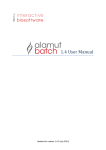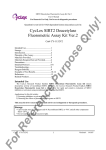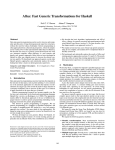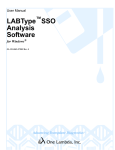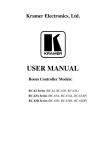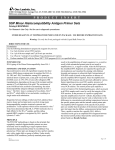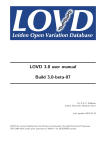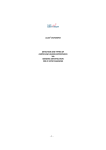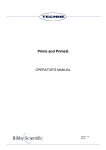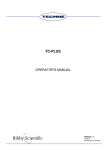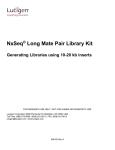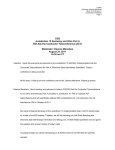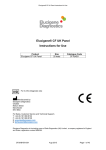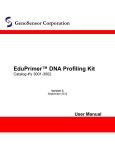Download KIR SSO GENOTYPING TEST
Transcript
JavaScript must be enabled to view this document. Please enable JavaScript and reopen the document. 21001 Kittridge Street, Canoga Park, CA 91303-2801 USA Tel: +1 (818) 702-0042 Fax: +1 (818) 702-6904 P R O D U C T WEB: www.onelambda.com I N S E R T KIR SSO Genotyping Test Catalog #s RSSOKIR For Research Use Only. Not for use in diagnostic procedures. Table of Contents Intended Use.................................................................................... 1 Summary and Explanation................................................................ 1 Principles ......................................................................................... 1 Reagents ......................................................................................... 2 Instrument Requirements ................................................................. 3 Specimen Collection and Preparation............................................... 3 Procedure3 A. Materials Provided ........................................................... 4 B. Materials Required, but Not Provided .............................. 4 C. Materials Recommended, but Not Provided..................... 4 D. Step-by-step procedure. .................................................. 4 Directions for Use.............................................................................4 A. Bead Handling and Storage .............................................4 B. Amplification.....................................................................4 C. Test Set-Up......................................................................5 D. Test Procedure ...............................................................8 Results ...........................................................................................8 Limitations of the Procedure .............................................................8 Expected Values ...............................................................................9 Specific Performance Characteristics ............................................10 Bibliography ....................................................................................10 Licensing, Patents, and Trademarks ..............................................10 European Authorized Representative..............................................10 Summary of Protocol for 96-Sample Assay ....................................11 INTENDED USE For the identification of KIR genotypes. SUMMARY AND EXPLANATION KIR gene alleles code for the MHC ligands, Killer cell Immunoglobulin-like Receptors on NK cells. Human KIR genes are tightly clustered on human chromosome 19q13.4, with various patterns of duplication of single or multiple genes, as well as occasional deletions. Several of the KIR genes were originally sequenced by the HUGO Genome Nomenclature Committee (HGNC).1, 2 The polymorphisms of KIR are spread over the entire length of the genes. At least three separate amplifications (Exon 3+4, 5, and 7-9) are needed for low resolution typing with reverse SSO oligonucleotide probes. 3 Because of the nature and irregular number of KIR genes in each haplotype, the KIR system is as complex, if not more complex, than the HLA loci for performing genetic typing. New KIR alleles are still being identified as DNA samples from different ethnic groups are analyzed and sequenced. The KIR SSO Genotyping Test provides a research tool for exploration of KIR heterogeneity and the investigation of a possible role in transplant outcome. PRINCIPLES The KIR SSO Genotyping Test applies Luminex® technology to the reverse SSO DNA typing method. First, target DNA is PCR-amplified using three separate group-specific primer sets targeting Exons 3+4, 5, and 7-9. Each PCR product is biotinylated, which allows later detection using R-Phycoerythrin-conjugated Strepavidin (SAPE). Each PCR product is denatured and allowed to hybridize to complementary DNA probes conjugated to fluorescently coded microspheres. After washing the beads, bound amplified DNA from the test sample is tagged with SAPE. A flow analyzer, the LABScan™ 100, identifies the fluorescent intensity of PE (phycoerythrin) on each microsphere. The assignment of genotypes is based on the reaction pattern compared to patterns associated with published KIR gene sequences. 4 REAGENTS A. Identification The KIR SSO Genotyping Test provides a panel of oligonucleotide probes immobilized on microspheres for identification of specific alleles in amplified genomic DNA samples through a controlled DNA-DNA hybridization reaction, followed by flow analysis using the LABScan™ 100 flow analyzer. The system components consist of: Pre-optimized and tested mixture of microspheres with probes covalently attached Hybridization reaction buffers to facilitate the binding of target DNA to the probe Wash Buffer to wash off unbound DNA SAPE buffer for diluting Stock SAPE solution KIR-RSSO-PI-EN-00, Rev 4 Page 1 of 12 JavaScript must be enabled to view this document. Please enable JavaScript and reopen the document. DNA amplification reagents (pre-optimized loci-specific primer mix) D-mix (specially formulated amplification). The microsphere mixture consists of a set of fluorescently labeled microspheres that bear unique sequence-specific oligonucleotide probes for the targeted alleles. Each microsphere mixture includes a negative and positive control probe beads for subtraction of non-specific background signals and normalization of raw data to adjust for possible variation in sample quantity and reaction efficiency. The microsphere mixtures are pre-optimized for particular PCR products obtained by DNA amplification using the locus-specific primer mixes. The primer mixes are pre-optimized for amplification of specific genes from 40 ng of purified genomic DNA in 20 l volume when used in conjunction with Dmix, the prescribed amount of recombinant Taq polymerase, and the PCR reaction profile detailed below. For each lot, see provided Worksheet for the specific alleles that can be identified and the Bead Probe Information document for the recognition site of each probe. B. Warning or Caution 1. For Research Use Only. Not for use in diagnostic procedures. 2. Warning: Ethidium bromide, which is used for gel staining and which is not included with this product, is a known carcinogen. Handle with appropriate caution. Can be harmful if absorbed through skin. Avoid splashing in eyes or on skin or clothing. Keep tightly sealed. Wash thoroughly after handling. Flush spill area with water spray. 3. Warning: Denaturation Buffer and Neutralization Buffer are corrosive and may cause burns. In case of contact, immediately flush eyes or skin with a copious amount of water for at least 15 minutes while also removing contaminated clothing and shoes (see MSDS). 4. Caution: The Bead Mix is light sensitive and must be protected from light. 5. Caution: Use the Bead Mix within three months after it is thawed. 6. Refer to the Material Safety Data Sheet for detailed information. C. Instructions for Use See "Directions for Use." D. Storage Instructions All of the reagents and buffers can be safely stored frozen at -80 to -20 C in the product box. Avoid unnecessary handling. It is recommended that you keep the entire package intact and frozen upon receipt until ready to use. However, once the bead mixtures are thawed for use, they should be stored at 2 to 8C and should never be refrozen. A brief summary of the required storage and handling conditions of the test reagents follows below. Use by expiration date on the label. Initial Storage Temperature Repeated Freeze-Thaw Storage Temperature after Thawing LABType Buffers (except SAPE buffer) -80º to 25º C Yes — SAPE Buffer -80º to 8º C No 2 to 8° C Bead Mixture -80 º to -20º C No 2 to 8° C for 3 months only Primer Sets -80 º to -20º C Yes — Taq polymerase -20º C Yes — DNA specimens -80 º to -20º C Yes — Amplified DNA in sealed tray -80 º to -20º C Yes — Component ® E. Purification or Treatment Required for Use See DIRECTIONS FOR USE. F. Instability Indications 1. Beads that exhibit discoloration, or aggregation that cannot be removed by vortexing, should be considered unusable. 2. If salts have precipitated out of any of the product reagents during shipping or storage, re-dissolve by extended vortexing at room temperature (20 to 25 C). KIR-RSSO-PI-EN-00, Rev 4 Page 2 of 12 JavaScript must be enabled to view this document. Please enable JavaScript and reopen the document. 3. D-mix aliquots, upon thawing at room temperature (20 to 25 C), should be pink to light purple in color. Any Dmix aliquot without the specified coloration should be considered unusable. INSTRUMENT REQUIREMENTS LABScan™ 100 flow analyzer Luminex® XY Platform (optional accessory for automated 96-sample reading on the LABScan™ 100 flow analyzer from Luminex Corporation) Centrifuge - Rotor for 1.5 ml microfuge tube (14,000 to 18,000 g) - Swing bucket rotor for 96-well microplate (1000 - 1300 g) Vortex mixer with adjustable speed 96-Well Gene Amp® PCR System 9600, 9700 or Veriti™ 96-Well Thermal Cycler (Applied Biosystems). Set ramp speed to 9600 for 96-Well Gene Amp® PCR System 9700. Set ramp speed to 9600 Emulation Mode for Veriti™ 96Well Thermal Cycler. Program your thermal cycler before starting the “Step-by-Step” procedure below. SPECIMEN COLLECTION AND PREPARATION A. DNA can be purified from human leukocytes by any preferred method. B. The DNA sample to be used for PCR should be re-suspended in sterile water or in 10 mM Tris-HCl, pH 8.0 9.0 at an optimal concentration of 20 ng/l with the A260/A280 ratio of 1.65 - 1.80. C. Samples should not be re-suspended in solutions containing chelating agents, such as EDTA, above 0.5 mM in concentration. D. DNA samples may be used immediately after isolation or stored at -20C or below for extended periods of time (over one year) with no adverse effects on results. E. DNA samples should be shipped at 4C or below to preserve their integrity during transport. PROCEDURE A. Materials Provided Note: The volumes provided are slightly more than the amount required for testing. This is to account for inadvertent losses that may result from pipetting. Do not mix components from different lots of products. 300 µl Denaturation Buffer Reagents (40 tests per package) 160 µl KIR SSO Bead Mix (exon 3+4) - Group 1 600 µl Neutralization Buffer 160µl KIR SSO Bead Mix (exon 5) - Group 2 4080 l Hybridization Buffer 160 µl KIR SSO Bead Mix (exons 7-9) - Group 3 60 ml Wash buffer 160 µl KIR Specific Primer Mix (exon 3+4) 5940 l SAPE Buffer 160 µl KIR Specific Primer Mix (exon 5) 1656 Primer Set D-Mix 160 µl KIR Specific Primer Mix (exons 7-9) B. Materials Required, but Not Provided Deionized water 70% ethanol 20% chlorine bleach (or equivalent) R-Phycoerythrin-Conjugated Streptavidin--SAPE) (OLI Cat. #LT-SAPE) Sheath fluid (OLI Cat.#LXSF20 or LSXF20X5) Recombinant Taq polymerase (Amplitaq Polymerase, Roche Molecular Biochemicals, Part # 20759562018) 15 - 50 ml disposable tubes 96-well, thin-walled PCR tray, or tubes, and holder that can withstand 1000 – 1300 g in a centrifuge Caution: PCR plate must have tight contact with heating block. Tray seal (OLI Cat. #SSPSEA300) Note: PCR trays (25) and tray seals (180) sufficient for 2400 samples can be ordered from One Lambda (OLI Cat. #PCRTRAC) Electrophoresis apparatus/power supply150V minimum capacity (Micro SSP™ Gel System, OLI Cat. #MGS108) UV transilluminator (example: Fotodyne FOTO/UV®21) KIR-RSSO-PI-EN-00, Rev 4 Page 3 of 12 JavaScript must be enabled to view this document. Please enable JavaScript and reopen the document. Photographic or image documentation system 1x TBE buffer (89mM Tris-borate; 2 mM disodium EDTA, pH 8.0) with 0.5 g/ml ethidium bromide or 5XTBE Buffer with ethidium bromide (OLI Cat. # 5XTBE100) Electrophoresis grade agarose (e.g., FMC Seakem® LE) PCR Pad Crushed ice C. Materials Recommended, but Not Provided 1.5 ml microfuge tube (USA Scientific 1.5 ml Graduated Microfuge Tubes - Cat. #1415-2500) Pipette tips (Rainin -GPS 10G, 250, 1000) UNIPLATE, 96 well, 250 l microplate (Whatman No. 7701-2250, 7701-3250, or equivalent with a non-treated surface) Aluminum foil D. Step-by-step procedure. See "Directions for Use" below. DIRECTIONS FOR USE Caution: Special care must be taken in the aliquoting process. Failure to follow the steps described below may result in reagent loss. A. Bead Handling and Storage 1. Use of the recommended plastic ware (tubes, trays, and tips) can minimize loss of beads due to non-specific adhesion. (See "Material Required, but Not Provided.") 2. Bead Mixes can settle and aggregate if left in a tube. Beads must be evenly distributed before dispensing. Always mix beads vigorously by pipetting several times or by vortexing in horizontal position for 10 to 30 seconds, or as much as necessary, to obtain fully homogeneous mixture. 3. Bead Mixes are packaged in an aluminum foil bag. Do not remove beads from foil bag until ready to use. 4. Bead Mixes contain fluorescent dye. To avoid photobleaching of the beads, protect beads from light during usage and storage. Store beads at -20º C in the tightly capped tube provided until ready to use. Cover beads with aluminum foil or equivalent during assay. Cautions: Once beads are thawed, store beads at 2 to 8ºC and use within 3 months. Do not refreeze beads. Open bags containing Amplification Primer Mixture and D-Mix only in pre-amplication area. Store these items at -80 to -20 C in the pre-amplification area. B. Amplification (Set up in pre-amplification area.) 1. Enter the recommended PCR Program, into your thermal cycler as shown in Table 2. Confirm all parameters. 2. Turn on the thermal cycler to warm up heated lid. 3. Thaw DNA, Amplification Primers, and D-Mix. Keep on ice until use. 4. Adjust the concentration of genomic DNA to 20 ng/l using sterile water. 5. Vortex D-mix and Amplification Primer for 15 seconds; centrifuge for 3-5 seconds. 6. Set up three separate amplification reactions for each DNA sample. These PCR reactions utilize primer mixes for KIR Exon 3+4 (Group 1), Exon 5 (Group 2), and Exon 7-9 (Group 3), respectively. 7. Using Table 1 below, mix indicated volume of D-mix and Primers. Vortex for 15 seconds, and place on ice. For accurate pipetting of Taq polymerase, it is recommended that you prepare master mix for at least 10 reactions. 8. Add Taq polymerase immediately before use. Table 1: Amplification Mixture (One PCR reaction per Primer Mix) D-mix Amplification # of Reactions (l) Primer (l) 1 13.8 4 10 138.0 40 50 690.0 200 96 1491.0 432 KIR-RSSO-PI-EN-00, Rev 4 Taq Polymerase (l) 0.2 2.0 10.0 21.6 (22) Page 4 of 12 JavaScript must be enabled to view this document. Please enable JavaScript and reopen the document. 9. 10. 11. 12. 13. 14. 15. Pipette 2 µl of DNA (at 20 ng/l) into the bottom of a tube (for final volume of 20 µl per PCR reaction). Store the tubes or tray partially covered to prevent evaporation and contamination. Add an appropriate amount of Taq polymerase (e.g., 0.2l per 20 l reaction) to the Amplification Mixture prepared in Step B.6. Vortex for a few seconds, and centrifuge for 3-5 seconds. Aliquot 18 µl of Amplification Mixture into each well containing DNA. Caution: To prevent cross-contamination, be sure not to touch the pre-aliquoted DNA at the bottom. Cap or seal. If you are using a tray seal, make sure it is pressed tightly against the rim of each well. Place a PCR Pad appropriate for your thermal cycler on the tray before closing the lid. Close and tighten the lid of the thermal cycler. Run the PCR program shown in Table 2. For GeneAmp PCR System 9700, set “ramp speed” to the 9600 program. For other systems, consult the manufacturer’s documentation to adjust ramp speed to closely simulate the GeneAmp 9600 program. Use of a significantly different ramp speed will affect amplification efficiency. Table 2: KIR SSO Genotyping PCR Program (OLI-2) Temperature and Step Incubation Time # of Cycles Step1: 1 96ºC 03:00 Step 2: 96ºC 00:20 5 60ºC 00:20 72ºC 00:20 Step 3: 96ºC 00:10 30 60ºC 00:15 72ºC 00:20 Step 4: 1 72ºC 10:00 Step 5: 1 4ºC forever 16. Amplified DNA is now ready to be tested using the Test Procedure in section D. However, it is recommended to first use 2 - 5 µl of amplified DNA for analysis by gel electrophoresis. Confirmation of an amplification product (band) prior to hybridization assay ensures generation of optimal signals. 17. Store covered DNA tray at -80 to -20 C for up to one month. C. Test Set-Up 1. Turn on the LABScan™ 100 and XY Platform and follow the start-up procedure described in Section D of the Directions for Use. The LABScan™ 100 requires at least 30 minutes to warm up. 2. Turn on thermal cycler and run program to 60°C HOLD, or equivalent, for at least 1.5 hours (or hold forever). Have a PCR Pad appropriate for your thermal cycler ready for use. Be sure to wait until the heated lid of the thermal cycler reaches the appropriate temperature before use. Use the appropriate 96-well PCR tray holder to ensure the proper incubation temperature. 3. Remove all reagents (except brown 100X SAPE bottle) from storage to room temperature. Be sure to prepare 1X SAPE during the third wash step. Remove the 100X SAPE bottle from storage only when needed, and return immediately to 2 to 8° C. Return any unused portions of the Bead Mix and the SAPE Buffer to 2 to 8° C. (Do not refreeze Bead Mix after thawing.) 4. Prepare reagents for the reverse SSO hybridization reaction using Tables 3, 4, and 5 below. Aliquot the necessary volumes into clean containers, repeating for each Bead Mix provided. Continued on next page KIR-RSSO-PI-EN-00, Rev 4 Page 5 of 12 JavaScript must be enabled to view this document. Please enable JavaScript and reopen the document. Table 3: Reagent Preparation* Amount per Test 4 µl Reagent Bead Mix Preparation Method and Suggestions Aliquot appropriate volume, plus extra volume*, for the required number of tests into a clean tube at room temperature. Protect from light. Use the entire contents of the Bead Mix tube for 96 samples. Keep at 2° to 8° C after thawing (stable for only 3 months at this temperature.) Vortex immediately before use. Hybridization Buffer 34 µl Aliquot for exactly the same number of tests as used for the Bead Mix. Add to pre-aliquoted Bead Mix to prepare Hybridization Mixture. Keep at 20 to 25 C . Wash Buffer 480 µl Aliquot appropriate volume, plus extra volume*, for the required number of tests. Keep at 20 to 25 C . Denaturation Buffer 2.5 µl Aliquot appropriate volume, plus extra volume*, for the number of tests. Keep at 20 to 25 C . Neutralization Buffer 5 µl Aliquot appropriate volume, plus extra volume*, for the number of tests. Keep at 20 to 25 C . 0.5 µl During the last centrifugation step, prepare 1X SAPE solution by making 1:100 dilution of SAPE Stock with SAPE Buffer for the appropriate number of tests, plus extra volume.* Protect from light. Keep diluted SAPE at 20 to 25 C . Keep SAPE Stock bottle at 2 to 8° C. SAPE Stock (100X) SAPE Buffer 49.5 µl *Note: The extra volume required depends on pipetting technique and calibration status of equipment. For reagents provided in excess volume, such as Denaturation and Neutralization Buffer, you may use a trough for multichannel pipetting. Table 4: Reagent Volumes* Number of Tests 1 10 20 50 96 Denaturation Buffer (µl) 2.5 25 50 125 240 Neutralization Buffer (µl) 5 50 100 250 480 Hybridization Buffer (µl) 34 340 680 1700 3264 Wash Buffer (µl) Tray Method 480 4800 9600 24000 46080 Bead Mixture (µl) 4 40 80 200 384 Table 5: SAPE and SAPE Buffer Volumes* Number of Tests 1 10 20 50 96 SAPE Stock Volume (µl) 0.5 5.0 10.0 25.0 48.0 SAPE Buffer Volume (µl) 49.5 495.0 990.0 2475.0 4752.0 Note: Volume of reagents in Tables 4 and 5 are for the exact number tests. The actual number of aliquots differs depending on pipetting accuracy. For a full 96-sample assay, we recommend 460 µl of each Bead Mix (tested separately) with 57.5 l stock SAPE, and 5693 l of SAPE buffer, which is slightly more than the exact amount required for the test. *Three separate tests are performed on each DNA sample using the three Bead Mixes. KIR-RSSO-PI-EN-00, Rev 4 Page 6 of 12 JavaScript must be enabled to view this document. Please enable JavaScript and reopen the document. D. Test Procedure TECHNICAL PRECAUTIONS 1. To assay a small number of samples (48 or fewer) you may use a 96-well tray, a tray that has been cut to the appropriate number of wells, or a 0.2 ml thin-wall PCR strip tube. Be sure to use a tube rack when using a cut-off tray or strip tube. 2. Mixing of samples in a 96-well tray involves sealing of the tray and low speed vortexing for a few seconds. Adjust the speed of the vortex mixer so that liquid inside the 96-well PCR tray is sufficiently agitated without excessive splashing. Note the speed setting, and use it for the 96-well tray method. 3. Sealing of the 96-well PCR tray should be done carefully and completely to prevent well-to-well sample contamination. Seal the tray by pressing the seal against each rim of the 96 wells. Do not re-use tray seals. Use a fresh seal for each step that requires application of a tray seal. A repeater pipet may be used where applicable; however, a repeater pipet is usually less accurate in volume delivery. 4. We recommend regular calibration and a manual volume check for each pipetting device. Do not use a repeater pipetting device for dispensing the Hybridization Mixture. 1. Denaturation/Neutralization a) Prepare a crushed ice bath. b) Place a clean 96-well plate in a tray holder. c) Transfer 5 l of each amplified DNA sample into a well of a clean 96-well plate. Make sure sample location and ID are noted. d) Add 2.5 l Denaturation Buffer. Mix thoroughly (preferably by pipetting up and down), and incubate at room temperature (20 - 25 C) for 10 minutes. e) Add 5 l Neutralization Buffer with pipet, and mix thoroughly (preferably by pipetting up and down). Note the color change to clear or pale yellow. f) Place PCR plate with neutralized PCR product on ice bath or equivalent. Keep the plate on ice until step 2c below. Caution: Avoid contamination of PCR product with water. 2. Hybridization Note: Make sure that the thermal cycler has been turned on and the 60C program has been started to warm the thermal block. a) Combine appropriate volumes of each Bead Mix with Hybridization Buffer to prepare three separate Hybridization Mixtures. b) Add 38 l Hybridization Mixture to each well. Make sure that the correct Hybridization Mixture is added to the wells with the corresponding amplified DNA for the exons. c) Cover tray with tray seal and vortex thoroughly at low speed. d) Remove from tray holder and place PCR tray into the pre-warmed thermal cycler (60 C). e) Place PCR Pad on top of tray or caps on PCR tubes. Close and tighten lid. Incubate for 15 minutes. f) Place tray in tray holder and remove tray seal. Quickly add 100 l Wash Buffer to each well. Cover tray with tray seal. Centrifuge tray for 5 minutes at 1000 -1300 g. Place tray in tray holder and remove wash buffer. g) Repeat step 2.f above two more times for a total of three wash steps. Remember to prepare 1X SAPE solution during third centrifugation. 3. Labeling a) Place tray in tray holder. Add 50 l of 1X SAPE solution to each well. Place tray seal on tray and vortex thoroughly at low speed. Place tray in the pre-heated thermal cycler (60 C). Place PCR Pad on top of tray or caps on PCR tubes. Close and tighten lid. Incubate for 5 minutes. b) Remove tray. Place tray in tray holder. Remove seal and quickly add 100 l Wash Buffer to each well. c) Cover tray with tray seal. Centrifuge tray for 5 minutes at 1000 – 1300 g. Place tray in tray holder and remove supernatant. KIR-RSSO-PI-EN-00, Rev 4 Page 7 of 12 JavaScript must be enabled to view this document. Please enable JavaScript and reopen the document. d) Add 70 l Wash Buffer to each well. Gently mix by pipetting. Transfer to reading plate using an 8- or 12channel pipet. Avoid sample- to-sample contamination by using fresh pipet tips. Note: Final volume should be at least 80 l. e) Cover tray with tray seal and aluminum foil. Keep tray in the dark and at 4C until placed in the LABScan™ 100 for reading. f) Read results for each Bead Mix in a separate session on the LABScan™ 100. g) For the best results, read samples as soon as possible. Prolonged storage of samples (more than 4 hours) may result in loss of signal. Store samples overnight at 4C in the dark with a tray seal, if they cannot be read immediately. Be sure to thoroughly mix the samples immediately before reading. 1 2 3 4 5 6 7 8 9 11 10 12 A B C D E F G H Figure: The Luminex® XY Platform reads the sample in the following pattern: A1 to H1, A2 to H2...A12 to H12. 4. Data Acquisition: Described below is a general guide to data acquisition. Details on the use of the LABScan™ 100, may be found in the “Luminex® 100 User’s Manual” for the software version you are using. a) Turn on the system and set up the LABScan™ 100 for ample acquisition and calibration according to the Luminex® to the “Luminex User’s Manual”1 for the software version currently being used. b) Choose a template according to the product catalog ID and lot number. 1) Acquisition templates are available from One Lambda on a CD or are downloadable via the One Lambda website. 2) To create your own acquisition template, follow the instructions in the Acquisition chapter of the” Luminex User’s Manual.”5 Start Up c) Create a file name for the samples to be run. d) Make sure all the template settings are correct. e) Enter the sample IDs. Caution: If the same sample is tested more than once, a different ID should be assigned. f) The plate is now ready to run. g) Load the plate onto the XY platform and fill the reservoir with sheath fluid. h) Click on the START button to initiate the session. After the samples have been run, the data output should be saved in a .csv file. i) Wash the machine 2 times with sheath fluid at the end of the session. RESULTS Data Calculation A. The fluorescence intensity (FI) generated by the Luminex® Data Collector software, or equivalent, contains the FI for each bead (or probe bound to the bead) per sample. The percent positive value is calculated from the trimmed mean data as: Percent Positive Value = 100 x [FI (Probe n) - FI (Probe Negative Control)/FI (Probe Positive Control) - FI (Probe Negative Control)] The positive reaction is defined by the percent of positive values for the probe higher than the pre-set cut-off value for the probe. The negative reaction is defined as the percent of positive values lower than the cut-off value. B. Compare calculated percent positive values to the pre-determined cut-off values for each test probe. Assign a positive attribute to probes that have a percent positive above the cut-off and a negative attribute to those below the cut-off. The FI of the positive control should be within 1000 - 4000 FI. (The FI value may fall outside of this range (see Expected Values, Section C) and varies for each positive control probe and lot.) The FI of each probe is normalized against the KIR-RSSO-PI-EN-00, Rev 4 Page 8 of 12 JavaScript must be enabled to view this document. Please enable JavaScript and reopen the document. positive control FI and is expressed as a percentage of the positive control FI. The pre-set cut-off value for each probe was established using a 100- to 200-sample DNA panel. C. Determine the genotyping of the sample by matching the pattern of positive and negative bead IDs with the information in the product worksheet. LIMITATIONS OF THE PROCEDURE The KIR SSO Genotyping Test combines a locus-specific DNA amplification process and DNA-DNA hybridization process. The procedure, as well as the equipment calibration described in this product, must be strictly followed. DNA amplification is a dynamic process that requires highly controlled conditions to obtain PCR products that are specific to a target segment of KIR gene(s). The procedure provided for the DNA amplification process must be strictly followed. In particular, since sample DNA quantity and quality can significantly affect the amplification reaction, a standardized DNA extraction procedure and spectrophotometric measurement of DNA quantity and quality, followed by gel electrophoretic analysis, are strongly recommended. In addition, to avoid contamination of initial materials with PCR products, all materials generated after DNA amplification (post-PCR materials, including reaction mixes; all disposable plastics; and equipment, such as pipetting devices and gel electrophoresis devices) must be physically separated from materials used before DNA amplification (pre-PCR materials including all disposable plastics, pipetting devices, sample DNAs, all other reagents used to set up amplification reactions). Frequent wipe tests to detect PCR product during the pre-PCR steps are strongly recommended. The DNA-DNA hybridization-based assay using reverse SSO is a very temperature-sensitive process. The temperature used for the assay must be checked frequently (calibrated). Strict adherence to the temperatures and incubation times described in this procedure is critical for obtaining optimal results. The Bead Mixes are light sensitive and must be protected from light as much as possible. Avoid freezing and thawing to ensure maximum shelf life. To minimize a loss of microspheres during the assay, follow the protocol described here and use only recommended pipette tips and tubes. The microsphere mixture provided contains a carefully optimized quantity of microspheres sets bearing allele specific probes. Any alteration of the mixture would significantly affect the accuracy of the assay and would void the results. When compared to SSP, SSO has more ambiguities because the probes used in SSO can interrogate sample DNA at only one region per test, and SSP can interrogate sample DNA at two regions per test. This is a basic limitation of the SSO method, which is well understood by the DNA laboratory professional. All instruments (e.g., thermal cycler, pipetting devices, LABScan™ 100 and heat block) must be calibrated according to the manufacturers’ recommendations. For lot-specific information, refer to the Bead Probe Information document. Because of the complexity of the polymorphic genes associated with the KIR system and the frequent updating of allelic definitions, a DNA technician or specialist should review and interpret the data, and assign the genotyping. This product is for research use only and cannot be used for the basis of any clinical decision. No claim or representation is intended to provide information for the diagnosis, prevention or treatment of a disease. The performance characteristics of the product have not been established, and it is not cleared or approved for clinical use by the United States FDA. In addition, the product is not CE marked for IVD use in the European Union. EXPECTED VALUES A. Sample Amplification 1. The locus-specific primer mixes provided are expected to yield adequate quantity of amplified DNA. Failure to detect an amplification product by ethidium bromide stained agarose gel electrophoresis voids test results. 2. DNA amplification is subject to contamination by previously amplified DNA. Detection of contamination (by performing a control amplification using water or pre-established DNA wipe test for detection of contaminating amplification products) can void test results. B. LABScan™ 100 Analyzer 1. The LABScan™ 100 is an advanced flow analyzer that requires daily maintenance and calibration. Refer to the Luminex® 100 User Manual5 for all necessary maintenance operation. Daily maintenance includes routine start-up and shut-down procedures. For best performance, calibrate the instrument as part of the start-up routine. Calibrate KIR-RSSO-PI-EN-00, Rev 4 Page 9 of 12 JavaScript must be enabled to view this document. Please enable JavaScript and reopen the document. 2. the instrument whenever the d Cal Temp temperature shown on the system monitor panel is more than 3º C. The instrument must pass a calibration test before samples are analyzed. C. Data Acquisition and Analysis In order to obtain valid data, two parameterscount and fluorescence intensitymust be monitored for each data acquisition. The count represents the total number of beads analyzed and should be above 100. A significant reduction in the count suggests bead loss during sample acquisition or assay and can void test results. Fluorescence intensity (FI) represents a PE signal detected within the counted beads. FI varies based on reaction outcome. Under the conditions defined in “Specific Performance Characteristics” below, the FI for the positive control probe is expected to be 500 or above. Values outside of this range can be valid and yield accurate typing as long as assay performance is validated using the user’s reference samples under his or her routine assay condition. Any unassignable reaction pattern accompanied by a significant fluctuation of the positive control FI value may suggest inadequate sample quantity and/or quality, poor assay efficiency, or instrument failure. SPECIFIC PERFORMANCE CHARACTERISTICS In normal samples and using assay and data acquisition conditions that are within the specifications described in this product insert (e.g., starting genomic DNA concentration of 20 ng/μl and purity, OD260/280 of 1.65 to 1.80, hybridization incubation temperature and washing conditions, and the LABScan™ 100 analyzer performance status), positive and negative reactions are determined by comparing the relative fluorescence intensity (FI) of a sample to its corresponding cutoff value. The cut-off value has been experimentally determined for a given lot of the product, and the cut-off is used to distinguish between positive and negative signals, based on the genotype of a sample. The results are expected to reflect the presence or absence of certain allele(s), providing a clean-cut typing assignment. Device performance studies were done using the QIAamp DNA Blood Maxi Kit sold by Qiagen Corporation. The KIR Genotyping Test was validated using 48 DNA samples from the 13th International Workshop and over 200 other sequenced samples. BIBLIOGRAPHY 1. Martin AM, Freitas EM, Witt CS, Christiansen FT. The genomic organization and evolution of the natural killer immunoglobulin-like receptor (KIR) gene cluster. Immunogenetics 2000; 51:268-80. 2. Marsh SGE, Parham P, Dupont B, Geraghty DE, Trowsdale J, Middleton D, Vitches C, Carrington M, Witt C, Guethlein LA, Shilling H, Garcia CA, Hsu KC, Wain H. Killer-cell immunoglobulin-like receptor (KIR) nomenclature report, 2002. Tissue Antigens 2003; 62:79-86. 3. Crum KA, Logue SE, Curran MD, Middleton D. Development of a PCR-SSOP approach capable of defining the natural killer cell inhibitory receptor (KIR) gene sequence repertoires. Tissue Antigens. 2000 Oct; 56(4):313-26. 4. Immuno-Polymorphism Database (http://www.ebi.ac.uk/ipd/kir/). 5. Luminex® 100 User’s Manual, Luminex Corporation, latest version applicable. LICENSING, PATENTS, AND TRADEMARKS USED IN THIS DOCUMENT PATENTS USED IN THIS DOCUMENT The KIR SSO Genotyping Test reagents are manufactured and distributed by One Lambda, Inc., 21001 Kittridge Street, Canoga Park, CA 91303, U.S.A. Recombinant Taq polymerase is manufactured by F. Hoffmann-LaRoche. ™Amplitaq is a trademark of Roche Molecular Biochemicals. ™LABScan is a trademark of One Lambda, Inc. ™Veriti is a trademark of Applied Biosystems. ®Gene Amp is a registered trademark of Applied Biosystems. ®Luminex is a registered trademark of Luminex Corporation. ®Pipetman is a registered trademark of Rainin Instrument Co., Inc. ®Fotodyne FOTO/UV21 is a registered trademark of FOTODYNE Incorporated. ®FMC SeaKem is a registered trademark of FMC Corporation. KIR-RSSO-PI-EN-00, Rev 4 Page 10 of 12 JavaScript must be enabled to view this document. Please enable JavaScript and reopen the document. Summary of Protocol for 96-Sample Assay A. Pre Set-Up 1. Turn on LABScan™ 100 analyzer, and begin the start-up procedure. Turn on the thermal cycler, and start 60°C incubation program. 2. Prepare crushed ice bath (add small amount of water to allow PCR tray to stand straight on ice) 3. Thaw and vortex D-Mix and DNA. 4. Remove all reagents (except 100x SAPE bottle) from storage temperature and use at room temperature. Thoroughly mix Hybridization buffer and each Bead Mix in a separate clean tube; protect from light. B. Amplification (Prepare separate reactions for each Primer Mix.) 1. Thaw all amplification reagents, and place on ice. 2. Aliquot 2 l genomic DNA to each of 96 wells in a PCR tray. 3. Mix 432 l of Primer Mix, 1491 l of D-Mix, and 22 l of Taq polymerase. Vortex well and give a quick spin. 4. Aliquot 18 l of Amplification Mix from Step 3 into all 96 wells containing DNA. 5. Cap or seal the PCR tray. 6. Run the tray in a PCR oven using the KIR SSO Genotyping PCR program. 7. Remove the PCR tray from the PCR oven, and check the amplified DNA on a 2.5% agarose gel (use 5 l per well). C. Denaturization/Neutralization 1. In a clean, thin-walled 96-well PCR tray, aliquot 2.5 l Denaturation Buffer per well. 2. Add 5 l per well of amplified DNA. Note the sample locations in the 96 wells. 3. Mix thoroughly until the mixture changes to a bright pink color. 4. Incubate at room temperature (20 to 25º C) for 10 minutes. 5. Add 5 l per well of Neutralization Buffer. 6. Mix thoroughly until the mixture turns clear or pale yellow. 7. Place tray carefully on the ice bath. D. Hybridization/Washing (Prepare separate reactions for each Bead Mix.) 1. Aliquot 38 l Hybridization Mixture (from A.4.above) per well into all neutralized DNA for the corresponding exons. 2. Place a seal on the tray and vortex thoroughly at low speed. 3. Incubate the tray in a 96-well block in a 60ºC thermal cycler (use PCR Pad) for 15 minutes. 4. Take out the tray. Add 100 l of Wash Buffer to each well. Place a new seal on the tray, and spin at 1000 g for 5 minutes. 5. Remove supernatant, leaving approximately 10 l or less. 6. Repeat Steps D.4 and D.5 two more times for total of 3 washes. 7. During the last centrifugation step, prepare 1X SAPE (57.5 µl Stock and 5693 µl SAPE Buffer) and leave covered at room temperature. E. Labeling 1. After removal of supernatant from the third wash (D.6 above), add 50 l 1X SAPE per well. 2. Place a seal carefully on the tray and vortex thoroughly at low speed. 3. Incubate at 60ºC in thermal cycler as above for 5 minutes. 4. Take out the tray, and add 100 l Wash Buffer to each well. Place a new seal on the tray and spin at 1000 g for 5 minutes. 5. Remove supernatant. Add Wash Buffer to make the final volume 80 l. 6. Mix by pipetting and transfer all samples to a 96-well microplate for data acquisition. Read each Bead Mix separately. KIR-RSSO-PI-EN-00, Rev 4 Page 11 of 12 JavaScript must be enabled to view this document. Please enable JavaScript and reopen the document. REVISION HISTORY Revision Date Revision Description 0 2005/06 Initial Release. 1 2005/11 Clarify positive control values “Expected Values” Section, step C. Clarify adding the beads when the plate is on ice, “Directions for Use” Section, step D.1.f. 2 2007/01 Reword storage instructions and add table (pg 2). Correct typo (pg 4) for Whatman plate #. Add step to Instrument Requirements (pg 3). 3 2009/02 Instrument Requirements section: Add Veriti 96-Well Thermal Cycler; Separated “Thermal Cycler” into two words.; Template Update 4 2009/05 Updating document to include Exon 3+4 as Group 1; added statements in Limitations of Procedure section. KIR-RSSO-PI-EN-00, Rev 4 Page 12 of 12
















